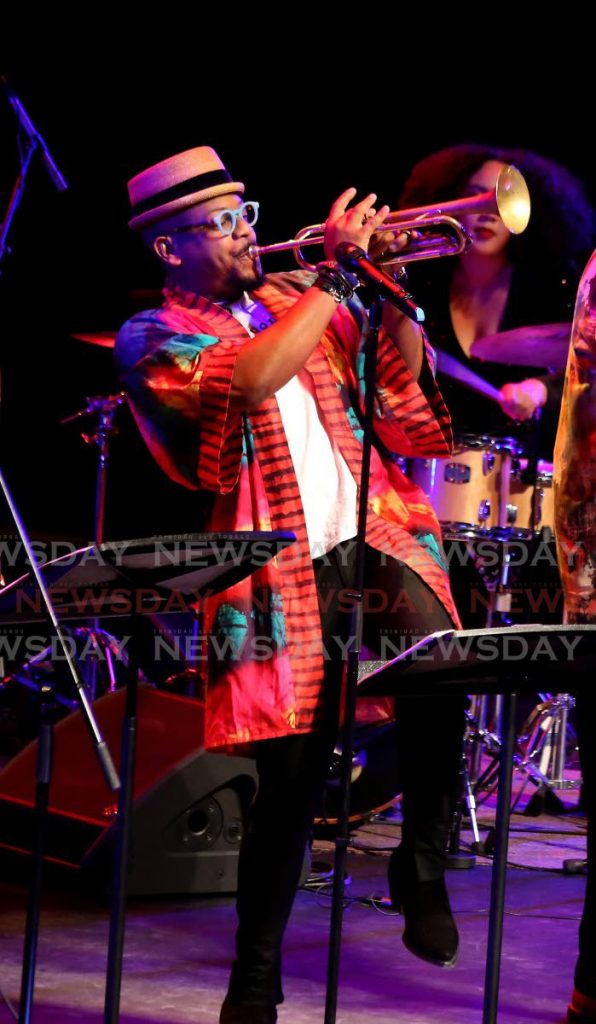Charles sees Christmas our way

NIGEL A CAMPBELL
Creole Christmas 2.0: Venezuelan Roots – a review
In a season of annual Christmas pageants and choral events that get local audiences excited, Etienne Charles’s return to the stage for the 2.0 version of his Creole Christmas: Venezuelan Roots celebration on December 5 was a needed fillip for the entertainment options that seem to veer away from the contemplation of local art towards the experience of a festive adventure.
However, in this case, the two are not mutually exclusive, but integral to showcasing Charles’s Caribbean perspective on the important music of and inspired by the Christmas celebrations.
Quite literally, this concert presents the idea that TT is part of the wider Americas, and specifically, people in the Caribbean engage with music and the season not via the depictions on a Hallmark postcard or the co-opted Coca-Cola image of Santa Claus, but by the rhythms of musical collaborations from the past, by the celebration of old friends meeting and singing the songs and dancing to the drumbeat that pulses in the veins informed by the African-Caribbean heartbeat.

Afro-Venezuelan parranda and calypso were enhanced by the language of jazz, with its improvisational intent, and by the recollection of a creole heritage that spans from New Orleans to Venezuela to produce music and an event that marks, in the capital city, a reconnection with our native insights and an opportunity to define what the season is to a wider cross-section of the population. Folk and popular music, well played, became lynchpins to making this event a mainstay on the Christmas calendar.
That arc of musical influences from New Orleans to Venezuela via the Antilles, from jazz to parranda, was provided to an eager audience by Charles and his top-flight musicians, especially the singers Betsayda Machado and Relator; parranda and calypso, two sides of the same coin that represents the songs of Trinidad Christmas. We know it when we hear it. Their respective tunes were the sing-along anthems that marked high points in the audience's awareness that the concert was more than good feelings and light entertainment. This was festivity and finding the centre.
Machado is a one of a kind. She is an Afro-Venezuelan queen of parranda whose deep, seductive, powerful contralto voice passionately conveyed to a receptive audience the potency of parranda, and showed that the calypso, which was transplanted to Venezuela by local migrations decades ago, has a resonance that allows for familiar songs to become universal. Accompanied just by cuatro, in the hands of a master, Jorge Glem, and cajon performed by Charles, Machado proved to this reviewer that the Trinidad model of parang, with four or more beautiful female singers harmonising in a throaty high pitch, is not necessary to move people and to effectively tell the story of an aguinaldo or a rio manzanares or a joropo.
Glem, by himself, also introduced the idea, murmured widely after the show, that his cuatro playing is on a different level than anyone’s in Trinidad. DNA or practice – who knows what’s responsible? – but his agile fingering, strumming and fretting made his solos and accompaniment veritable feasts for the ears. The Venezuelan roots of our creole Christmas, enhanced by the congas of Ernesto Garcia and the maracas of Clarita Rivas and Pascual Landeau on the parranda La Negrita Caridad, were laid bare by the familiarity of the rhythms and the melodies that are part of our national consciousness.
Before the concert, Charles said of jazz trombonist Wycliffe Gordon, “Nobody else can do what he does on trombone…I can't wait for TT to experience his artistry.” The wait was worth it. A number of tricks and effects were used by this consummate musician to amusingly make his trombone bray, bleat, whisper, but more importantly, to play the soothing yet joyful tone that guides marches and second lines in New Orleans jazz funerals. A jazz masterclass.
Notable that evening was Charles's use of public-domain material, including music recorded by Edric Connor and Lionel Belasco, and Tchaikovsky. His Dance of the Sugar Plum Fairy was given a Caribbean “hip-rotating” funky riddim that suggested, according to Charles, that the fairy was “from Belmont and not from Russia.” Belasco’s Roses of Caracas valse was played like a New Orleans funeral dirge, with competing solos from the horn men, while the Haitian hymn Fraiche Rosée was a music conversation piece between Gordon and Louis. Jazz at its finest within the context of Antillean melodic joy.
Relator, despite a “senior moment” on one song, made his and Spoiler’s Christmas calypsoes the new normal, and pan legend Earl Rodney caressed his double second pans to make a quiet duet with Charles on Tell Santa Claus a simple celebration of who we are. A highlight of the show was the medley of intimate Christmas ballad duets with pianist Sullivan Fortner; Gordon tenderly played What Child Is This? Haitian-American saxophonist Godwin Louis subtly rendered Who Would Imagine a King and Charles blew life into It Came Upon a Midnight Clear. The audience consensus was that this was the song cycle of the evening, generating tears.
For over two hours, the audience, a mature set with a small percentage of Charles’s peers, were regaled by a Caribbean context of Christmas, from the sounds to the way he was dressed in colourful tropical caftan-inspired robes – matched only, as always, by the nattily-dressed Louis – to the live parang lavway in the lobby at the end of the show, with wine and cheese (that was the one concession to European tropes) as "jorts" to accompany the pressing of flesh between fans and artistes.
Creole Christmas 2.0; Venezuelan Roots was entertainment, but more importantly, for the large audience, it was a further enlightenment towards being proud of what TT's people can do and who they are, even at Christmas time.


Comments
"Charles sees Christmas our way"